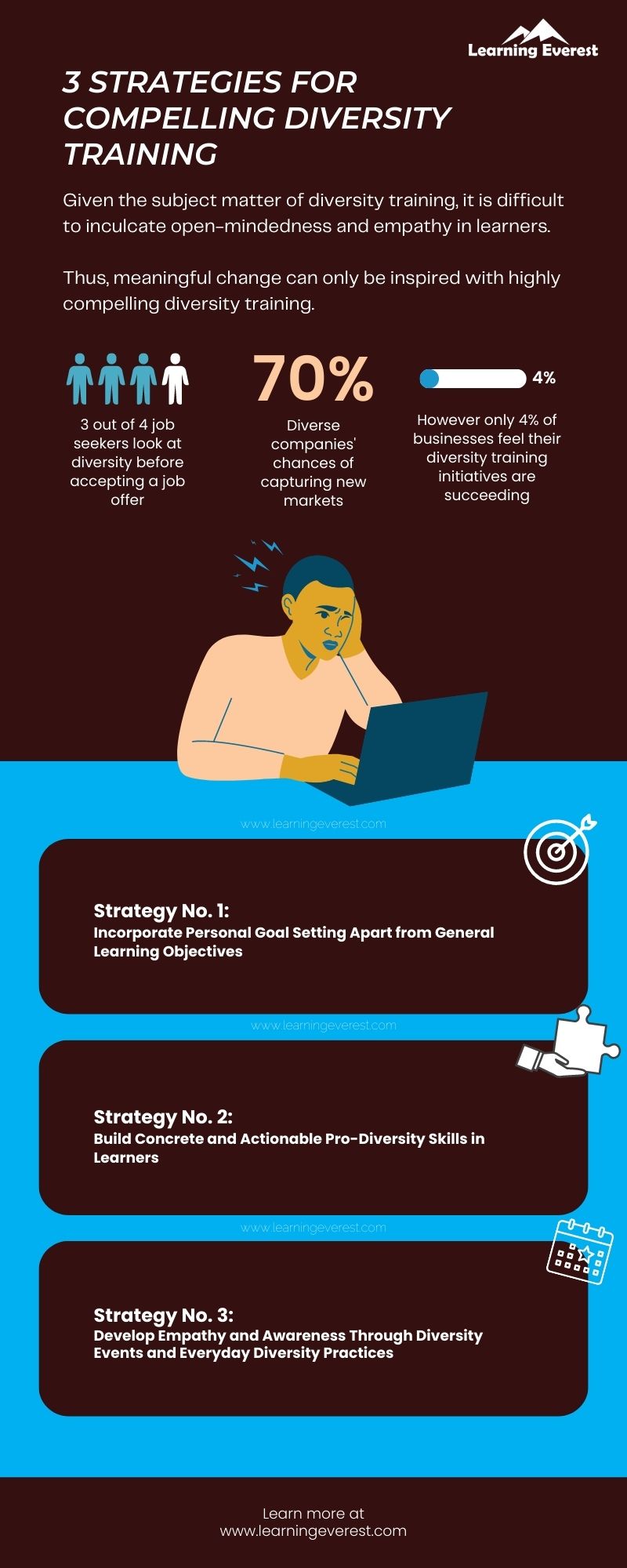Achieving the desired diversity training results from diversity training programs is not always as easy as it seems for organizations. Inspiring meaningful change among employees often requires delivering highly compelling diversity training to learners. Given the subject matter of diversity training and humans’ natural tendency to resist change and view differences with caution, it can be difficult to inculcate open-mindedness and empathy in learners. This is reflected in PwC’s finding that only 4% of businesses feel their diversity training initiatives are succeeding. In this article, you will find 3 strategies for building compelling diversity training programs.
Table of Contents
What is Diversity Training?
Diversity training aims to build cultural awareness among participants so they understand each other better and appreciate and respect each others’ differences. Diversity training also deconstructs biases to enable people to see each other through a more holistic lens. Some of the training topics diversity training tackles are:
- Workplace demographics, diversity statistics, and diversity issues
- Uncovering and transforming unconscious biases
- Inclusion and allyship behaviors
- Identifying and reporting discriminatory or hostile behaviors
- Communication and teamwork in diverse settings
Why Does Compelling Diversity Training Matter?
As you can probably tell from the list above, the subject matter for diversity training involves challenging learners to get out of their comfort zone.
Diversity training often brings undesirable things about oneself to the surface, requires grappling with inherent privilege, and pins the expectation of eventual personal change on the learner.
Thus, due to the transformational nature of diversity training, it can be met with more resistance than any other form of organizational training.
This is why businesses need compelling diversity training programs, i.e., programs that can break past psychological and cultural barriers to produce significant changes in learners’ thoughts, feelings, beliefs, and behaviors.
3 Strategies for Compelling Diversity Training
Here are 3 strategies you can implement in your next round of diversity training to achieve better results.
Incorporate Personal Goal Setting Apart from General Learning Objectives
The first strategy for a compelling diversity training program is to incorporate goal setting as one of the core learning activities.
Encourage learners to set 2-3 diversity-related goals for themselves at the beginning of a program or after they have finished a program.
Such goals act as personal commitments that learners willingly take to embody greater respect and tolerance for the diversity around them.
For example, a learner could set a personal goal to start offering their own pronouns when introducing themselves to new people so as to create an opening for others to do so, too, if they choose to.
This strategy is also backed by research. According to a Harvard Business Review study, undergraduate students receiving diversity training who set personal diversity and inclusion goals for themselves displayed more pro-diversity behaviors after a three-month period.
Build Concrete and Actionable Pro-Diversity Skills in Learners
Another strategy for compelling diversity training is developing concrete and actionable skills in learners. When your employees have a personal toolkit of constructive behaviors they can implement to increase pro-diversity behaviors, they will feel more empowered.
Another benefit of skill-building is that it does not directly prescribe ways of thinking or feeling. Such changes are very likely to stir up resistance in learners, making diversity training efforts counterproductive.
Some skills you can include are:
- Advocacy, speaking up against discriminatory behavior, and allyship
- Using inclusive language
- Tools to identify unconscious biases in oneself and work through them using self-reflection and cultural awareness
- Multicultural understanding
Develop Empathy and Awareness Through Diversity Events and Everyday Diversity Practices
While formal training is a proven strategy for increasing pro-diversity behaviors, its ability to inspire learners fluctuates based on how well the delivery resonates with them.
Thus, non-traditional approaches that naturally build awareness and empathy are a highly compelling diversity training strategy. Events, clubs, and everyday practices are a great way to achieve this. Additionally, such diversity efforts allow employees from different backgrounds and identities to socialize and get to know each other.
Here are some tips to implement this approach:
- Use global diversity awareness events to do the same in your organization. For example, dedicate black history month to highlight the achievements of black employees. It is worth mentioning here, though, that such efforts are most meaningful when minority communities receive fair and equal treatment year-round, even when the spotlight is not on them.
- Start an office book club with a diverse reading list. Employees can sign up and participate by choice. Forums, chat groups, message boards, and small groups can also be used to hold discussions about the books and their real-life implications.
- Hold office potlucks where people can share cultural cuisine. While this might not spark direct conversations about diversity, it will develop multicultural awareness among employees.
- Allow employees and leaders to share their experiences on a platform. Some examples include a live or virtual speech, a community blogpost, a social media post on the company’s accounts, etc. You can also invite guest speakers to do the same.
Infographics
Frequently Asked Questions (FAQs)
What is the purpose of diversity training?
Diversity training aims to build cultural awareness among participants so they understand each other better and appreciate and respect each others’ differences. Diversity training also deconstructs biases to enable people to see each other through a more holistic lens.
How to deliver compelling diversity training?
Some strategies to deliver compelling diversity training are:
- Incorporate personal goal setting apart from general learning objectives
- Build concrete and actionable pro-diversity skills in learners
- Develop empathy and awareness through diversity events and everyday diversity practices






